
In recent years, with the vigorous development of vocational education, strengthening school-enterprise cooperation in vocational colleges and promoting the integration of industry and education has become the focus and trend of the development of vocational colleges and universities. This study first analyzes the school-enterprise cooperation model based on triple fusion and explores the relationship status and role mechanism in school-enterprise cooperation. Then, the internal management structure and role mechanism of school-enterprise cooperation are studied, and the school-enterprise cooperation management system of vocational colleges and universities is constructed in response to the huge data and basic information processing generated in school-enterprise cooperation. Finally, a survey was conducted to analyze the construction of school-enterprise cooperation practice projects in vocational college M to explore the effects of the construction of typical practice projects. The average rating of vocational college M was higher than 3.50 in all seven dimensions, and the assessment results were all approved. The survey respondents with master’s degree or above had a lower rating of 4.01. In the development trend of school-enterprise cooperation in Vocational Institution M, the number of cooperative enterprises and specialties of school-enterprise cooperation increased by 105 and 25 respectively. The employment rate of the school increased to 96.77%, and the satisfaction of the alma mater and the satisfaction of the enterprises increased by more than 5%, indicating that with the deepening of the school-enterprise cooperation in M vocational colleges and universities, it has significantly helped the improvement of the quality of the students and the employment rate, and it has formed a benign interactive situation, which has provided a guiding value for the development of the school-enterprise cooperation in vocational colleges and universities.
he fundamental characteristic of the project-based course lies in its adoption of work tasks as the core teaching content, and the design of learning projects as vehicles for delivering typical products or services, thereby structuring the educational process. The work tasks integrated into these courses are meticulously processed and refined from authentic enterprise projects, enabling students to effectively bridge the gap between their academic training and the requirements of industry positions through the classroom-based implementation of such projects [1-3]. Consequently, the development of high-quality project-based courses holds significant practical implications.
The teaching project serves as a vehicle for disseminating knowledge imparted by instructors, and the selection of suitable and rational projects is intimately tied to the overall instructional quality of the course and the nurturing of students’ vocational competencies. Currently, the development of project-based courses typically involves a collaborative effort between academic professionals and industry experts, with a tendency to overlook the central focus of instruction—the students. This oversight may lead to a disconnect between the chosen teaching projects and the students’ needs and receptiveness [4-5]. Teachers constitute the primary agents of curriculum development, directly influencing its execution and efficacy. Meanwhile, enterprise experts possess a keen understanding of current and future occupational positions and their associated competency requirements. However, in the current landscape of project curriculum construction, the role played by enterprise experts remains inadequate. Many courses merely involve enterprise experts in defining occupational competency objectives and positions, failing to fully leverage their expertise in project development and subsequent refinement. Consequently, there exists a gap between the developed projects and their actual integration into workplace contexts [6-8].The development and construction of project-based courses necessitate a collaborative effort between academic institutions and enterprises, spanning from work process analysis to the organization, implementation, and evaluation of course instruction. Consequently, the establishment of a robust school-enterprise cooperation mechanism is imperative. A well-functioning interaction mechanism serves as a vital safeguard for the successful completion of project-based courses [9-11]. Presently, within the realm of project curriculum construction, the interaction mechanism between schools and enterprises necessitates further refinement.
Upon analyzing the prevalent issues in the current construction of project-based courses, this paper proposes a novel approach to project course development—the school-enterprise collaboration method. Within this framework, the primary stakeholders of course construction encompass professional teachers, enterprise experts, and students, all of whom are actively engaged throughout the entire process, from the initial determination of the teaching project to its subsequent refinement. The integration of enterprise experts and students into the curriculum development team not only ensures the development of high-quality projects but also aligns the teaching project with the students’ receptiveness, thereby circumventing the pitfall of “teaching for the sake of teaching” and “projects for the sake of projects.” This approach significantly enhances the feasibility and practicality of the projects and, in turn, elevates the vocational competencies of the students [12-15].
This paper delves into the mechanism of school-enterprise cooperation underpinned by triple integration, emphasizing the pivotal role of the government. Subsequently, we optimize the internal management mechanism of school-enterprise cooperation through three key aspects: incentive mechanisms, collaborative talent education, and teacher training. Based on this foundation, we establish a comprehensive management system tailored to the data management requirements of school-enterprise collaborations. Furthermore, we analyze the development of typical cooperative practice projects at M Vocational College as a case study, examining the evolution of teacher teams and the broader trends in school-enterprise cooperation. Our findings highlight the advantages of school-enterprise cooperation and offer strategic recommendations for its future development, thereby providing a solid foundation for enhancing such partnerships in vocational education institutions.
The concept of school-enterprise cooperation was first introduced in the 1920s, particularly in the realm of engineering and technology education within American universities, where the notion of school-enterprise cooperative education emerged. This concept is deeply rooted in and influenced by the medieval apprenticeship training system. School-enterprise cooperation is primarily driven by market mechanisms, with the content and modalities of cooperation guided by societal demands. It represents a collaborative endeavor between schools and enterprises aimed at nurturing and developing vocational talents. The overarching objective is to equip students with high comprehensive qualities, robust professional skills, and enhanced employability prospects, thereby benefiting both enterprises and society. Furthermore, this program strives to seamlessly integrate the resource strengths of enterprises with those of universities and to effectively bridge classroom theoretical knowledge with practical work experiences, ultimately fostering well-rounded and skilled professionals for the benefit of society.
The school-enterprise cooperation examined in this paper is a government-led collaborative model, which has stimulated the vitality of school operations through continuous promotion of institutional and mechanistic innovations in education. It has established a school-enterprise cooperation system and mechanism characterized by ’triple integration’: integration of school and industry, integration of profession and enterprise, and integration of teaching and production, with government participation and leadership, industry guidance, and cooperative construction by both enterprises and schools. This has gradually formed a multi-party collaborative, mutually beneficial, and win-win pattern.
Figure 1 illustrates the school-enterprise cooperation mechanism of triple integration. Based on this mechanism, several key steps should be taken. Firstly, it is imperative to actively leverage the government’s leading role in guiding resources from all parties, coordinating their interests, and implementing market-oriented operations to cultivate talents suited for regional economic development. Secondly, industrial enterprises should invest in school operations with capital, equipment, technology, and human resources, and participate in formulating talent training programs, norms, and standards within schools to deepen school-enterprise cooperation. Thirdly, schools should assume the primary role in school operations, focusing on co-educating talents, leveraging their own strengths, providing venues and professional teachers, and offering human resource support and technical services to enterprises. Fourthly, it is crucial to explore innovative mechanisms for school-enterprise cooperation, establish a modernized vocational education system, organize various skill competitions, cutting-edge industry training sessions, and conduct vocational skill assessments. While some cooperation exists in areas such as professional settings, personnel training objectives, training programs, the scale of training base construction, collaborative practice teaching, the introduction of part-time teaching resources, the establishment of an information-sharing network platform, and the creation of a remote transmission system, there has been no substantial progress in conducting applied technology research and promoting the transformation of scientific and technological achievements.
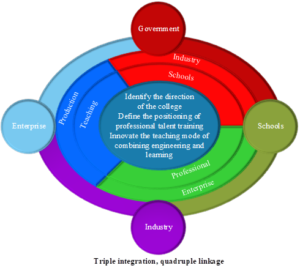
In the development of school-enterprise cooperation in vocational colleges and universities, the internal management of this cooperation holds particular importance. It is crucial to continuously deepen the reform and innovation of the internal administration and distribution mechanism, and strive to perfect an efficient incentive mechanism. This should fully integrate economic and social benefits to calculate the salary compensation for teachers’ participation in school-enterprise cooperation and technical services, incorporating it into the scope of teachers’ post duties and standard workload, linking it to their final salary, and considering it as a significant index for title evaluation and annual assessment. Teachers are encouraged to engage in enterprise technology research and development-related work, with rewards implemented for applied technology service teams and individuals. A long-term mechanism has been established for introducing part-time teachers from enterprises, facilitating the sharing of high-level talents with these institutions.
The internal management structure of school-enterprise cooperation is depicted in Figure 2. Regarding the incentive mechanism, a competition mechanism has been instituted through reforms in title evaluation, job designation, and the salary system, aimed at guiding teachers to actively engage in teaching reform. The annual performance evaluations, performance-based pay management, and promotion prospects for teachers and managers have been reinforced. In terms of the talent co-cultivation mechanism, in-depth cooperation between schools and enterprises is realized through joint research on specialty development, curriculum system design, teacher strength augmentation, practice base construction, expansion of school-enterprise cooperation enterprises, coordination of graduation internships and employment, and joint evaluation of talent cultivation quality by both schools and enterprises. This is achieved through joint training initiatives, enabling college theoretical professionals to participate in enterprise management and allowing college teachers to immerse themselves in the forefront of enterprise operations, engaged in technical work. Simultaneously, enterprise managers and technicians are brought into the classroom to interact with students, thereby fostering stronger integration between teachers, enterprises, and technicians.
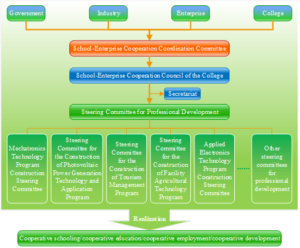
The functional architecture of the school-enterprise cooperation management system is depicted in Figure 3. The system primarily comprises five functional modules: cooperation opportunity management, enterprise resource management, cooperation affairs management, comprehensive query, and system management. Specifically, cooperation opportunity management encompasses school-enterprise mutual visit management and cooperation plan management. Enterprise resource management includes enterprise information management and enterprise resource loss management. Cooperation affairs management consists of cooperation agreement management, cooperation follow-up management, cooperation feedback management, and practical training project management of school-enterprise cooperation. Comprehensive query encompasses cooperative material inquiry, enterprise contribution analysis, professional contribution analysis, and other sub-functional modules. System management comprises school user management, enterprise user management, security management, and other sub-functional modules. Overall, the school-enterprise cooperation management system comprehensively covers all essential needs in school-enterprise cooperation and provides a scientific foundation for its further development.
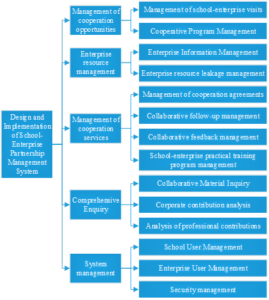
Figure 4 illustrates the data connection execution process of school-enterprise cooperation, which encompasses a substantial amount of data information pertaining to the collaboration between vocational colleges and universities. The stored procedures involved in this process constitute a type of executable object within the database management system. These stored procedures can be categorized based on application and functional divisions. According to application, they are classified as system stored procedures and user-defined stored procedures. Functionally, they are divided into those with parameters and those without. Stored procedures also exhibit flexibility in terms of return values, as they can be designed to either return a value or not. It is noteworthy that stored procedures differ from traditional functions in their execution mechanism. Specifically, stored procedures are executed via the database engine and may not necessarily return a value, whereas functions must always produce a result. The implementation of stored procedures within the dataset can alleviate the burden on the application program, enabling the resolution of complex issues within the database itself. In the .NET framework, the execution of stored procedures is facilitated through ADO.NET technology, which provides DataSet and DataAdapter objects. The system incorporates numerous functional applications of stored procedure technology. It is important to emphasize that stored procedure technology not only involves creation within the database but also requires appropriate execution on the application side. On the application side, SQL commands can be executed either directly or through stored procedures. The .NET Framework offers solutions for executing various types of stored procedures.
The process of executing a stored procedure on the application side is roughly as follows:
Memorize the procedure name accurately to prepare for the execution of the application.
Create a data adapter object and add parameters to the adapter object.
Set the type of the adapter object to be executed as a stored procedure.
Create a DataSet object.
Update the data through the update method of the DataSet object.
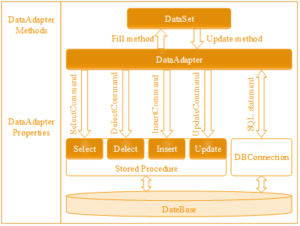
This study collects and processes data from three steps:
Questionnaire distribution and collection: Questionnaires were distributed to students participating in the school-enterprise cooperation project through schools and enterprises, with instructions to complete them within the prescribed time. Additionally, questionnaires were also administered to students who were not participating in the project to establish a comparison.
Data Statistics and Analysis: This section involves the statistical analysis of collected questionnaires, encompassing descriptive statistics and differential analysis. Concurrently, the data obtained from field observations were also organized and analyzed, which included sorting the interview content and reviewing the observation records of the practical teaching process.
Results Presentation: The results of the statistical analysis are organized and presented. The application of cooperation in practice teaching is illustrated through charts and words, and the feedback from students and teachers is also presented.
Taking the school-enterprise cooperation model of M vocational college as the research object, the survey designed a questionnaire for teachers, an interview outline for managers, and an interview outline for enterprise managers. The survey employed a 5-point Likert scale for scoring, with 5 representing “strongly agree”, 4 for “agree”, 3 for “neutral”, 2 for “disagree”, and 1 for “strongly disagree”. An item was considered “recognized” if its average score was \(\mathrm{\ge}\) 3.5 points. If the average score of a project fell between 2.5 and \(\mathrm{<}\) 3.5 points, it was deemed to have “basic recognition”. When the average score of a project was \(\mathrm{<}\) 2.5, it was considered “not recognized”. After the questionnaire passed the reliability and validity tests, a total of 205 questionnaires were distributed, with 185 questionnaires recovered and 178 valid questionnaires collected. These comprised responses from 152 teachers, 10 managers, and 26 employees of cooperative enterprises affiliated with M vocational college. Through the distribution of questionnaires and subsequent statistical analysis, this paper provides a realistic basis for the research.
This section analyzes the teacher development situation within the school-enterprise cooperation model presented in this paper across seven dimensions: teacher selection and hiring system, teacher work requirements, assessment and management system, teacher training system, teacher management system, teacher compensation system, and teacher protection system. The survey results regarding teacher development in school-enterprise cooperation are presented in Table 1. The top three highest ratings for teacher team development are the teacher training system (4.39\(\mathrm{\pm}\)0.25), the appraisal and management system (4.25\(\mathrm{\pm}\)0.54), and the teacher management system (4.12\(\mathrm{\pm}\)0.68). The mean scores for the teacher protection system and teacher compensation system ranked fourth and fifth, respectively, at 4.05\(\mathrm{\pm}\)0.64 and 3.98\(\mathrm{\pm}\)0.85. Conversely, the ratings for the hiring system and teachers’ job requirements were relatively the lowest, at 3.78\(\mathrm{\pm}\)0.89 and 3.68\(\mathrm{\pm}\)0.68, respectively. Overall, the ratings for the seven dimensions were all above 3.50, indicating recognition of the assessment results. This suggests that the triple fusion-based school-enterprise cooperation model has achieved notable successes in teacher team development and can effectively enhance the quality of teacher team building, although there remains room for improvement in teacher job requirements.
| Dimensions | Mean | Standard deviation | Evaluation result |
| Degree of employment | 3.78 | 0.89 | Admissive |
| Teacher’s job requirement | 3.68 | 0.68 | Admissive |
| Assessment management | 4.25 | 0.54 | Admissive |
| Teacher training system | 4.39 | 0.25 | Admissive |
| Teacher management system | 4.12 | 0.68 | Admissive |
| Teacher treatment system | 3.98 | 0.85 | Admissive |
| Teacher guarantee system | 4.05 | 0.64 | Admissive |
The results of the difference analysis regarding the evaluation of teacher team building are presented in Table 2. The P values for different genders and ages are 0.657 and 0.167, respectively, both of which are greater than 0.05, indicating no significant differences. The average scores for male and female students are 4.14 and 4.15, respectively, and the average scores for different age groups are 4.25, 4.31, 4.05, and 4.11, respectively. This suggests that evaluation subjects of different genders and ages generally hold similar views about the teacher team under the school-enterprise cooperation model presented in this paper, with the middle-aged group (30-40 years old) having slightly higher ratings. Meanwhile, the mean ratings for the three different academic qualification levels—bachelor’s degree, master’s degree, and master’s degree or above—are 4.62, 4.15, and 4.01, respectively. Their P-value is 0.038 (P \(\mathrm{<}\) 0.05), indicating variability in the views of different academic qualifications on the evaluation of teacher team building. Survey respondents with master’s degree or above have a lower rating of 4.01, suggesting relatively stricter scoring criteria. However, the overall recognition among evaluation respondents is high, ranging from 3.84 to 4.62. This further indicates that the school-enterprise cooperation model presented in this paper can effectively enhance the level of teacher training, promote the development of teachers’ abilities, and demonstrate excellent performance in teacher team building.
Through the survey statistics of school-enterprise cooperation in M vocational colleges, utilizing the cooperation model of this paper from 2015 to 2022, six aspects are analyzed: the number of majors involved in school-enterprise cooperation (A), the number of enterprises participating in school-enterprise cooperation (B), the number of curricula co-developed by the school and enterprise (C), the number of teaching materials co-developed by the school and enterprise (D), the number of students receiving positions in the cooperating enterprises (E), and the number of staff trained by the school for the enterprises (F). This analysis sets out to examine the situation of practical projects carried out by school-enterprise cooperation in vocational college M. The situation of school-enterprise cooperation in vocational college M from 2015 to 2022 is illustrated in Figure 5. Observations indicate that the number of enterprises participating in school-enterprise cooperation with M vocational colleges has risen from 100 to 205 annually from 2015 to 2022, with a corresponding increase in the number of majors involved, from 30 to 55, signifying an augmentation of 105 enterprises and 25 majors, respectively, engaged in this cooperation. As the school-enterprise cooperation model in M vocational colleges and universities has expanded and evolved, the scope of cooperation has enriched, and all pertinent indicators point to an upward trajectory. Specifically, the count of courses co-developed by the school and enterprise has escalated from 35 in 2015 to 45 in 2022, while the number of teaching materials co-created has jumped by 15 compared to the 2015 baseline. The student placements in enterprises have surged from 40 in 2015 to 242 in 2022, and the number of employees trained by schools for enterprises has escalated to 342, representing an increase of 202 students and 289 trained employees, respectively. Within the context of specialty development through school-enterprise cooperation, curricula and teaching materials are co-developed, enterprises contribute part-time teachers, and the school reciprocates with technical services and staff training, fostering a mutually beneficial and interactive partnership.
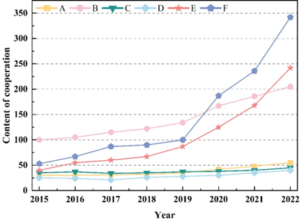
The development of school-enterprise cooperation in Vocational College M is further analyzed, with comparisons of changes and trends from 2015 to 2022 in four aspects: employment rate under the school-enterprise cooperation model, monthly income of graduates at the start of their jobs, satisfaction of alumni, and satisfaction of enterprises. The trend in school-enterprise cooperation development at Vocational College M is presented in Table 3. From 2015 to 2022, Vocational College M’s employment rate under the school-enterprise cooperation model increased from 90.45% to 96.77%, and the initial monthly salary of graduates increased from 2,480 yuan to 6,500 yuan. The satisfaction rate of alumni increased from 90.12% to 98.05%, and the satisfaction rate of enterprises increased from 93.44% to 99.21%, representing increases of 7.93% and 5.77% respectively. This indicates that as school-enterprise cooperation deepens, the quality and development of talent training have been effectively improved. The deepening cooperation between schools and enterprises plays a significant role in enhancing students’ quality and employment rate.
| Evaluation object | Mean | Standard deviation | T | P | |
| Gendre | Male | 4.14 | 0.84 | 0.115 | 0.657 |
| Female | 4.15 | 0.63 | |||
| Age | 20\(\mathrm{\sim}\)30 | 4.25 | 0.52 | 1.732 | 0.167 |
| 30\(\mathrm{\sim}\)40 | 4.31 | 0.31 | |||
| 40\(\mathrm{\sim}\)50 | 4.05 | 0.45 | |||
| Over 50 | 4.11 | 0.52 | |||
| Educational background | Bachelor degree | 4.62 | 0.22 | 2.521 | 0.038 |
| Master | 4.15 | 0.15 | |||
| Master degree | 4.01 | 0.17 | |||
School-enterprise cooperation is an effective means of promoting the sustained and healthy development of vocational education. With the establishment of a service-oriented vocational education system as the primary focus, it is imperative to continuously enhance government investment, actively implement school-enterprise cooperation in teacher training, and establish a working mechanism led by the government, autonomous in schools, and supported by enterprises for the construction of practical projects.
The cooperative strategy devised in this paper for vocational colleges and universities is adaptable to various educational and industrial requirements, making it applicable to different types of vocational institutions.
Strengthen the leading position of the government
Fully leverage the government’s leading role, formulate a corresponding guarantee system for school-enterprise cooperation tailored to the actual situation of both the school and the enterprise, and establish the cultivation of the teacher team through cooperation as a shared obligation of both the enterprise and the school. Establish corresponding liaison organizations, fully harness the role of government authorities overseeing enterprises and schools, and construct a bridge for cooperation between schools and enterprises. Additionally, establish a reasonable interactive relationship between schools and enterprises to facilitate the smooth operation of school-enterprise cooperation initiatives.
Emphasize school autonomy
Emphasize the establishment of a pertinent system for the development of teachers in school-enterprise cooperation, prioritize teacher training, and diversify the avenues for recruiting teachers. By incorporating professional technicians and managers from enterprises who possess solid professional theories and extensive practical experience, the ranks of technical education teachers are enriched. Enterprises leverage the talent pool of schools to conduct technology updates and project research and development, fostering mutual benefits between schools and enterprises and promoting the sustained development of school-enterprise cooperation and collaboration.
Emphasize enterprise support
Strengthen support for skills practice and part-time teaching staff, and establish training bases for school-enterprise cooperation that are founded on common consensus, in order to fully leverage the effective cooperation between schools and enterprises.
This paper analyzes the cooperation mechanism and internal management structure based on the triple-fusion school-enterprise cooperation model, and establishes the cooperation management system. Finally, it takes M vocational college as an example to conduct an empirical analysis of school-enterprise cooperation practice project construction and draw conclusions.
M vocational colleges received average ratings exceeding 3.50 across all seven dimensions, with survey respondents possessing a master’s degree or higher assigning a slightly lower rating of 4.01, despite relatively stringent rating criteria. Among these seven dimensions, the teacher training system and assessment and management system achieved the highest scores, respectively 4.39\(\mathrm{\pm}\)0.25 and 4.25\(\mathrm{\pm}\)0.54. Conversely, teachers’ job requirements received the relatively lowest scores, averaging 3.78\(\mathrm{\pm}\)0.89 and 3.68\(\mathrm{\pm}\)0.68. Vocational colleges and universities adopting the triple fusion school-enterprise cooperation model received positive evaluations regarding their teachers’ team building.
The number of enterprises participating in school-enterprise cooperation at M vocational colleges grew to 205, and the number of majors involved in such cooperation increased to 55. Compared to 2015, the number of courses jointly developed by schools and enterprises, as well as the number of teaching materials jointly produced, increased by 10 and 15 respectively. Additionally, the number of students who secured positions in enterprises and the number of employees trained by schools for enterprises also experienced a significant increase. This indicates that with the deepening of the school-enterprise cooperation mode in M vocational colleges and universities, a positive development trend has emerged, fostering mutual promotion between the two parties in their cooperative endeavors.
The employment rate and the average starting salary of graduates from M Vocational Institutions under the school-enterprise cooperation model have increased to 96.77% and 6,500 yuan, respectively. The satisfaction levels of both the alma mater and the enterprises have risen by 7.93% and 5.77%, respectively. This indicates that with the development of school-enterprise cooperation in M vocational colleges, the employment rate and income level of the graduates have been effectively increased, meeting the needs of both schools and enterprises.